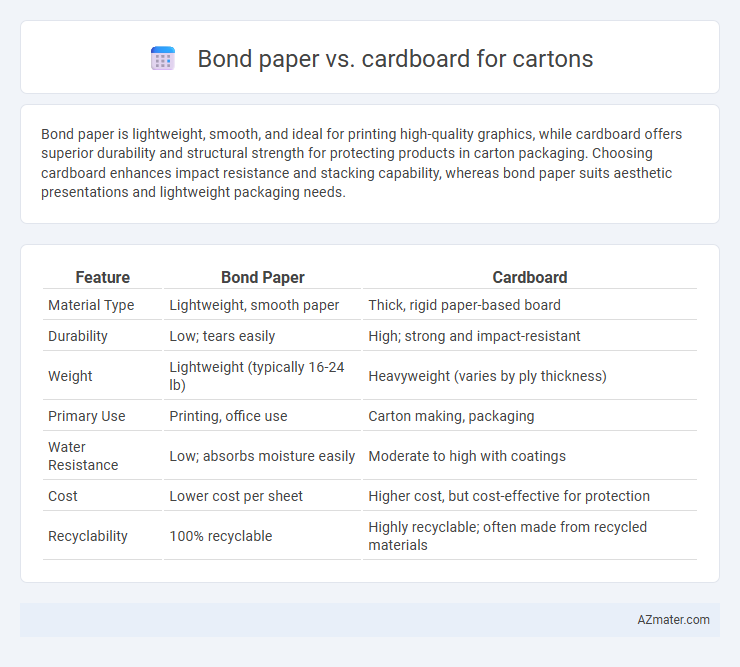Bond paper is lightweight, smooth, and ideal for printing high-quality graphics, while cardboard offers superior durability and structural strength for protecting products in carton packaging. Choosing cardboard enhances impact resistance and stacking capability, whereas bond paper suits aesthetic presentations and lightweight packaging needs.
Table of Comparison
| Feature | Bond Paper | Cardboard |
|---|---|---|
| Material Type | Lightweight, smooth paper | Thick, rigid paper-based board |
| Durability | Low; tears easily | High; strong and impact-resistant |
| Weight | Lightweight (typically 16-24 lb) | Heavyweight (varies by ply thickness) |
| Primary Use | Printing, office use | Carton making, packaging |
| Water Resistance | Low; absorbs moisture easily | Moderate to high with coatings |
| Cost | Lower cost per sheet | Higher cost, but cost-effective for protection |
| Recyclability | 100% recyclable | Highly recyclable; often made from recycled materials |
Introduction to Packaging Materials
Bond paper is a lightweight, smooth-textured material primarily used for printing and light packaging, offering flexibility and ease of customization. Cardboard, typically made from layers of paper pulp, provides rigid structural support, making it ideal for durable cartons and heavy-duty packaging. Choosing between bond paper and cardboard depends on the packaging requirements for protection, durability, and presentation.
Overview of Bond Paper
Bond paper is a high-quality, durable paper commonly used for office stationery and printing, featuring a smooth texture and strong fiber composition. It has excellent ink absorption and strength, making it suitable for lightweight carton packaging but less rigid compared to cardboard. Unlike cardboard, bond paper offers more flexibility and a finer finish, ideal for printed cartons that require detailed graphics and professional presentation.
Overview of Cardboard
Cardboard is a versatile and durable packaging material commonly used for cartons due to its rigidity and ability to protect contents during shipping and storage. It is typically made from multiple layers of paper pulp, creating a thick, sturdy board that offers superior strength compared to bond paper. Cardboard's eco-friendly properties and recyclability make it a preferred choice for sustainable packaging solutions across various industries.
Material Composition and Structure
Bond paper is typically composed of high-quality wood pulp fibers with minimal fillers, resulting in a smooth, lightweight, and flexible sheet ideal for printing and writing. Cardboard, made from multiple layers of kraft paper or recycled fiber pulp, features a rigid, thicker, and more durable structure suited for packaging and carton applications. The material composition of bond paper prioritizes smoothness and printability, whereas cardboard's layered structure provides enhanced strength and protection against impact.
Strength and Durability Comparison
Bond paper offers moderate strength suitable for lightweight packaging, whereas cardboard provides superior strength and durability, making it ideal for heavy-duty cartons and long-term storage. Cardboard's multi-layer construction enhances resistance to bending, crushing, and moisture, outperforming bond paper in protective capabilities. For applications requiring robustness and structural integrity, cardboard remains the preferred choice over bond paper.
Weight and Flexibility Differences
Bond paper is significantly lighter than cardboard, making it ideal for lightweight packaging applications where reducing shipping costs is a priority. Cardboard offers superior rigidity and strength due to its thicker construction, providing better protection for heavier or fragile items. The flexibility of bond paper allows easy folding and shaping, while cardboard's stiffness limits bending but enhances durability and structural integrity.
Printing and Customization Capabilities
Bond paper offers smooth surfaces ideal for high-resolution, detailed printing with vibrant color reproduction, making it suitable for intricate designs and fine text on cartons. Cardboard, while thicker and more durable, has a rougher texture that may limit the sharpness of printed images but excels in embossing, debossing, and custom die-cut shapes due to its rigidity. Both materials support various finishing options, but bond paper enables more precise digital printing, whereas cardboard is preferred for robust packaging with tactile customization features.
Cost Efficiency Analysis
Bond paper offers a cost-effective option for lightweight cartons due to its lower material and production expenses compared to cardboard. Cardboard, though pricier, provides superior durability and protection for heavier or fragile items, potentially reducing product damage costs. Balancing initial costs and long-term value, businesses often choose bond paper for budget-friendly packaging and cardboard when strength and product safety are priorities.
Environmental Impact and Recyclability
Bond paper is generally more environmentally friendly than cardboard for cartons due to its lighter weight and higher recyclability rate, reducing waste and energy consumption during processing. Cardboard, especially if uncoated and free from heavy inks or lamination, is widely recyclable and biodegradable but tends to have a larger environmental footprint because of its thickness and the resources required for production and transportation. Both materials contribute to sustainability when recycled properly, but the choice depends on the carton's durability needs versus minimizing environmental impact.
Ideal Applications: When to Use Bond Paper vs Cardboard
Bond paper is ideal for lightweight packaging, such as envelopes, flyers, and product inserts, where smooth surface quality and printability are essential. Cardboard is best suited for shipping boxes, retail packaging, and protective cartons requiring structural strength, durability, and impact resistance. Use bond paper for high-quality graphic presentations and cardboard for heavy-duty packaging and shipping needs.

Infographic: Bond paper vs Cardboard for Carton
 azmater.com
azmater.com